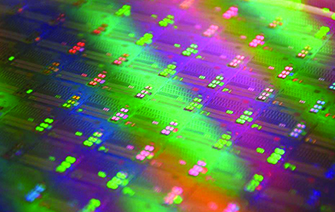MICROELECTRONICS
Success stories
Dolphin Design’s Tiny Raptor IP for IoT chip designers
This award-winning energy-efficient neural network AI accelerator designed for Edge AI deployment was developed with CEA through a joint R&D lab.

Weebit Nano newgeneration ReRAM for smart devices
Israel-based Weebit Nano, founded by seasoned semiconductor industry experts, is a CEA R&D partner on ReRAM IP for SoC designs.
It is the world’s first fully-integrated
neural-network-on-chip with nonvolatile
resistive memory.
Edge AI, in-memory computing, and neuromorphic computing for smart, fast, compact, secure, low-power IoT devices
As embedded AI algorithms become more sophisticated, they also become more data intensive. In-memory computing dramatically reduces the power consumption associated with data transfer between memory and logic while helping keep data more secure. New non-volatile memory technologies that imitate the human brain’s energy-efficient synapses are also driving new low-power solutions. CEA develops and integrates all these technologies for a range of IoT projects.
Edge AI—think smart sensors—is already here. It is what powers most IoT devices, which, instead of sending data to the cloud, process it right at the network “Edge.” In other words, the computer is embedded inside the sensor itself. New paradigms like in-memory and neuromorphic computing and new kinds of algorithms like incremental machine learning are helping achieve the necessary reductions in power consumption to make these advanced embedded systems viable options for your IoT projects.
CEA has a complete range of technologies to develop and prototype your Edge AI and tinyML chips to bring your IoT projects to life.
Expertise spanning embedded memory devices and the associated architectures
CEA’s
non-volatile memory solutions include PCRAM, ReRAM, and FeRAM for embedded applications. R&D on SOT-RAM recently begun, with results expected in 2023. FeRAM, which is very low power and offers record endurance, is expected to replace DRAM for embedded and stand-alone uses. We are also working on Back- End-Of-Line selectors like OTS materials. These solutions enable more compact, stable memory devices.
We can also bring our partners low-power, programmable in-memory computing architectures like
FPGA accelerators for deep neural networks designed to reduce data transfers between processing elements and memory, for huge energy savings.
Our
bio-inspired computing solutions include SPIKE neural networks that use nonvolatile memory as synapses, ideal for low-power vision systems.
CEA advantages for Edge AI
| "Advances in microelectronics at CEA are enabling new computing paradigms for secure, low-latency, low-power IoT solutions"

François Andrieu
Head of Laboratory, Nanodevices for Memory and Computing, CEA
|